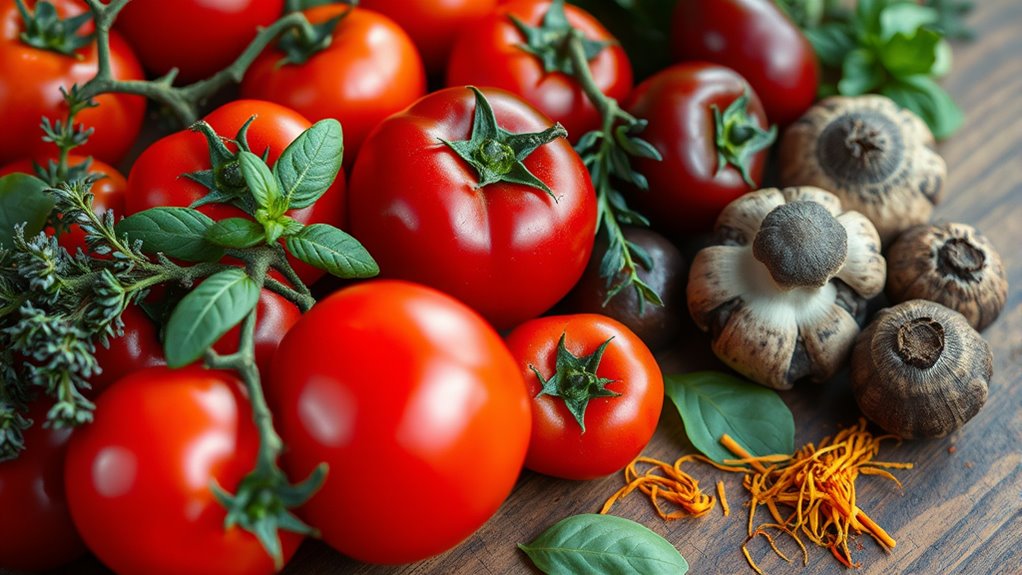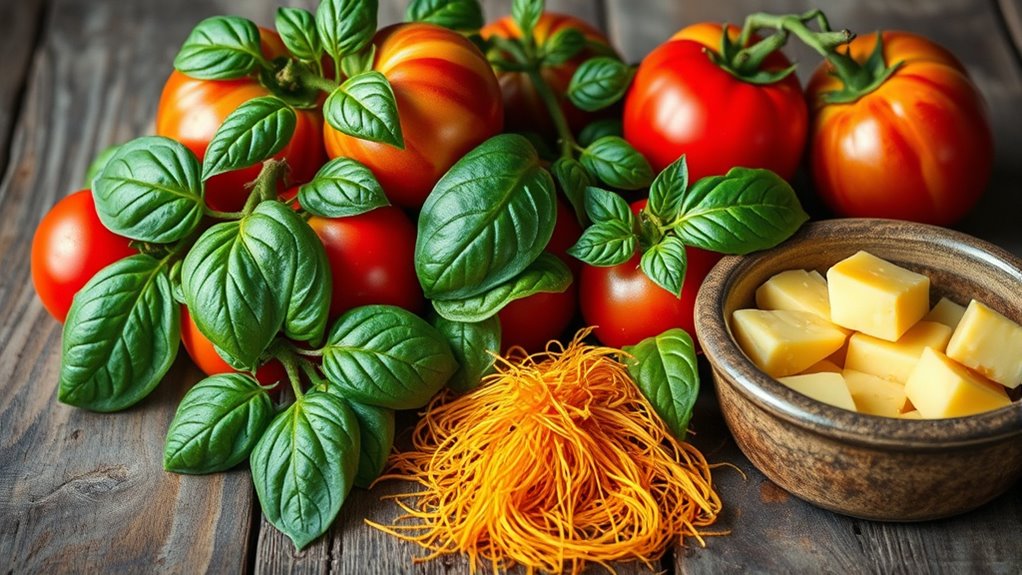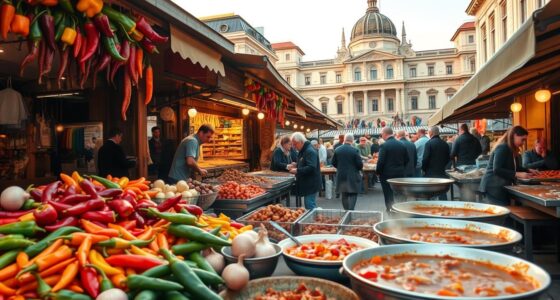By exploring world cuisines, you’ll discover how local ingredients shape distinct flavors and cultural identities. These ingredients, known as “terroir,” connect dishes to land, climate, and history, adding authenticity and depth. Using regional produce supports farmers, guarantees freshness, and reduces environmental impact. Embracing seasonality reveals vibrant tastes and nutritional benefits, all while preserving traditions. Continue exploring to uncover how these flavors tell stories of heritage and environment across the globe.
Key Takeaways
- Local ingredients shape the unique flavors and identity of regional cuisines, reflecting land, climate, and cultural heritage.
- They enhance authenticity, support local farmers, and ensure freshness, enriching the culinary experience.
- Seasonality aligns ingredients with natural growth cycles, boosting flavor, nutrition, and cultural significance.
- Using regional ingredients preserves biodiversity, tradition, and reduces environmental impact through sustainable practices.
- Incorporating terroir fosters a deep connection between cuisine, environment, and cultural storytelling.

Across the globe, local ingredients shape the unique flavors and identities of regional cuisines. When you explore a dish in its authentic context, you’re tasting more than just a recipe—you’re experiencing a connection to the land, climate, and culture that produced it. These ingredients, known collectively as terroir, influence everything from the aroma and texture to the visual appeal of your meal. They give each cuisine its distinct character, making it more than just sustenance but a reflection of local history and environment.
Imagine biting into a ripe, sun-kissed tomato in Italy’s Amalfi Coast or savoring a freshly caught fish from Japan’s coastal waters. These ingredients carry the essence of where they come from, and you can taste it in every bite. When a chef uses locally sourced ingredients, they’re not just supporting regional farmers and producers—they’re also ensuring the freshness and authenticity of the dish.
This emphasis on local ingredients transforms ordinary meals into memorable experiences that honor tradition and sustainability. Additionally, the use of high-quality, fresh ingredients enhances the overall sensory experience, making dishes more vibrant and flavorful.
In many cuisines, seasonality plays a crucial role. When ingredients are harvested at their peak, they bring more vibrant flavors and better nutritional value. For example, in France, the use of fresh herbs and seasonal vegetables highlights the importance of timing and local growth cycles.
In Mexico, chiles and corn are staples that reflect the climate and agricultural practices of the region. By choosing ingredients that are in season, you’re embracing a culinary rhythm that respects nature’s cycles, resulting in dishes that taste more alive and authentic.
Furthermore, local ingredients often carry cultural significance, deeply rooted in tradition. They tell stories of ancestors, migrations, and local innovations. When you incorporate these ingredients into your cooking or appreciate dishes prepared with them, you’re participating in a cultural exchange that preserves heritage and promotes biodiversity.
Supporting local farmers and artisans not only keeps regional flavors alive but also contributes to ecological balance, reducing the carbon footprint associated with transportation and industrial farming.
Ultimately, celebrating terroir through local ingredients encourages you to be more mindful of where your food comes from. It’s about more than taste; it’s a way to connect with the environment, respect local economies, and honor culinary traditions.
When you seek out and incorporate regional ingredients, you help sustain the diversity and richness of world cuisines, making each meal a celebration of place and identity.
Frequently Asked Questions
How Does Terroir Influence the Flavor Profiles of Local Ingredients?
Terroir profoundly influences the flavor profiles of local ingredients by shaping their unique taste characteristics.
You’ll notice that climate, soil, and altitude all contribute to the distinct aroma, texture, and flavor of produce, wine, or other ingredients.
When you use locally sourced ingredients, you’re experiencing the true essence of the land.
This connection enhances your dishes, making them more authentic and reflective of the region’s natural environment.
Are There Sustainability Concerns With Sourcing Local Ingredients Worldwide?
Like a double-edged sword, sourcing local ingredients worldwide can impact sustainability. You might reduce transportation emissions, but overharvesting or monocultures threaten ecosystems.
When you prioritize local, you support farmers and preserve biodiversity, yet you must also be mindful of resource use and environmental pressures.
Balancing local sourcing with sustainable practices guarantees you protect the earth while celebrating culinary diversity, making each dish a harmonious ode to nature.
How Do Local Ingredients Impact Cultural Identity in Cuisine?
You can see that local ingredients greatly influence cultural identity in cuisine because they reflect regional traditions and history. When you use ingredients unique to an area, it helps preserve cultural heritage and creates a sense of pride.
What Challenges Do Chefs Face When Sourcing Authentic Local Ingredients?
Think of sourcing authentic local ingredients as chasing an elusive butterfly. You face hurdles like seasonal shortages, limited access, and high costs.
Regulations and supply chain issues also complicate things, making it tough to maintain consistency. You might find yourself constantly adapting recipes or seeking alternatives.
Despite these challenges, your dedication helps preserve cultural authenticity, turning each dish into a vibrant tapestry of local flavors and stories.
Can Local Ingredients Be Adapted for Global Culinary Trends?
You can adapt local ingredients for global culinary trends by creatively blending traditional flavors with modern techniques. Focus on highlighting their unique qualities while experimenting with presentation and fusion concepts.
Embrace versatility, sourcing seasonally, and understanding regional nuances to make these ingredients appealing worldwide. This approach helps you celebrate terroir while aligning with current trends, creating authentic yet innovative dishes that resonate on a global scale.
Conclusion
By embracing local ingredients, you connect with the soul of a place—its terroir becomes your culinary story. Each dish becomes a tribute to tradition, a celebration of unique flavors that can’t be replicated elsewhere. When you choose to honor these ingredients, you’re not just tasting food; you’re experiencing history, culture, and identity in every bite. Remember, in the world of cuisine, local ingredients aren’t just ingredients—they’re the heartbeat of authentic flavor.









